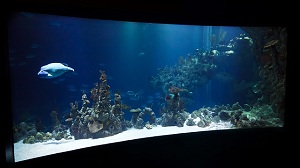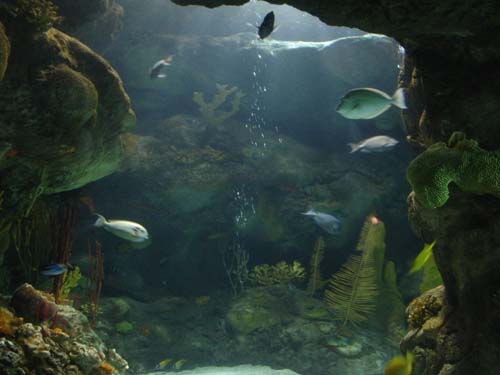For how long should aquarium lights be left on is a crucial decision and if not carefully tackled, can lead to other problems as well. Under all normal conditions, 10 hours is a good amount of time for lights to remain on in an aquarium.
If you have a planted tank then even a 12 hours duration will do good for an aquarium. Some experts consider 8 hours better, if you have a cold water tank with live plants.
If this is your first time with aquarium lighting then start with at least 8 hours and check the following things in your aquarium.
1) Plant growth rate
2) Fish behavior
3) Visual display
4) Rate of algae growth
5) Electrical consumption
Variations in any one of this are enough to disturb the equilibrium of your aquarium and this can cause serious health issues for your fish. That is why don’t add lights just because it looks good. Natural and artificial lights affect plant growth, which is good in a way but excess of it will increase responsibility on your part because such an aquarium will require careful maintenance.
Before you move further it is necessary to first understand on important aspect.
Table of Contents
Why does an aquarium require light?

Aquarium lights required in you have a planted tank and plants need light for photosynthesis. Plants consume carbon dioxide and exhale oxygen that gets mixed into water balancing the ecosystem in the fish tank water.
However while selecting lighting for your fish tank, it is necessary that you understand how much lighting is required. The power of lighting will vary depending upon the plant species you have picked for our fish tank.
Apart from this obvious reason, it also helps in the visual appeal of the tank and the inside of the tank can be enjoyed even during night hours or when external sunlight is low.
Is lighting necessary for a non planted tank?
If you have just fish and decorating items in your tank without live plants then you won’t need any artificial lighting as a rule. But many owners still prefer the visual quality it provides to the fish tank after evening hours and install lights.
However in case of a non planted tank the amount of hours you put the light son will be drastically minimal as compared to the hours of lighting in a planted tank. If you turn on light in a non planted tank for too long then this can encourage excess algae growth causing trouble. So if you have a non planted tank but still want to install artificial lights for the visual purpose, then follow a strict schedule and under all conditions avoid excess hours of lighting.
How to control lights when you are on vacation?
It’s difficult to answer this as there are many parameters to consider.
Ideally you must have a timer arrangement to turn on and turn off lights when you are on vacation to control and replicate the same conditions when you are at home taking care of lighting condition.
If you have a non planted tank then it’s better to turn off lights and go on vacation because under normal conditions fish tank without plants does not need lights.
If you have a planted tank then a timer arrangement will definitely help, but if you don’t have that then allow some natural light to enter the room where your tank is placed and let the sun take care of the lighting conditions. This will not be as accurate as the artificial lighting conditions you have created on your tank but should still make some things easier for the fish.
If you leave lights on for a longer time when you are on vacation then you will probably see excess algae growth in your tank and cleaning that will be a big job when you are back. Green algae is not bad for fish tank but if it grows out of control then you’ll have to consider some serious cleaning to control it.
What if the lights emit heat?
This is a serious problem to consider when fixing your lights above the fish tank. Many people don’t have an idea that lights can produce heat and this can affect the water temperature. Though this is not a very serious issue but in case of smaller tanks this can cause some trouble.
The solution to this is simple though. Incandescent lights produce heat and should be avoided for fish tank lighting. The perfect choice should be LED lights that produce a consistent lighting and produce negligible heat.
What if Algae starts to grow too fast?
Lighting of any type artificial or natural will definitely encourage algae growth in your fish tank. If you see green algae growing too fast in your aquarium then it is time to consider shifting pattern of lighting in your aquarium.
You can either reduce number of lights or reduce number of hours for which you turn them on. Normally a span of 8-12 hours lighting is sufficient for all types of tanks and fish species. Cold water fish will require a 8 hour cycle and will be sufficient, but a tropical tank 10-12 hours will do a good job. You can turn off lights during night hours to control algae growth as well.
Some LED light strips come with adjustable brightness arrangements. if you find that the algae growth is too fast you can try adjusting either color of light or it’s brightness so that you don’t have to invest in a new set up.
How to find if aquarium light is adequate or not?

When there is too much light then the first indication you will notice is growth of excess green algae. To cure this first you’ll need to do either reduce number of hours your light is on or reduce the intensity of your lighting attachment allows you to do.
However if you see brown algae growth then it is an indication of less amount of light. In that case you’ll need to increase the number of hours the light is turned on and start observing from this point.
The point here is when there is excess light it encourages plant growth as well as algae growth and algae consume nutrients that are required by plants as well. So a balance must be established and this can only be done by experimentation. Every tank has it’s own ecosystem because of size, fish species, number and types of plants and lighting conditions will vary from each tank to another.
Should I use colored lights in aquarium?
There is no special need to use colored lights in an aquarium because it’s not necessary for plant growth. On the other hand if you plan to use colored lights then enough care must be taken to first understand how they affect plant growth and fish health.
Many people buy a blue light commonly called as “moonlight”. This produces amazing display in the fish tank and is visually very appealing. When fixed above the fish tank this produces an amazing display in your living room or the space where this tank is present.
However if kept on for a longer time blue light encourage algae growth too fast and must be controlled under all conditions. You must have a timer arrangement for such kind of set up that controls on and off timings for this sort of lighting.
Actually blue and red lights are considered the best when it comes to growth of aquatic plants. These colored lights will also make you fish look visually appealing.
Just like blue light, read light also helps plant growth but only if you are able to control it’s on and off schedule using a timer arrangement.
If you think that normal while LED lights are too bright or are catching up too much attention in your aquarium set and disturbing the interior design theme of your home space, then consider using a colored light for aquarium.
How to calculate power consumption of LED lights?
Since it is clear that the aquarium light is going to be operational on for anything in between 8-12 hours a day depending upon your particular situation, it is necessary to understand how much power it’s going to consume.
Fortunately LED lights are cheaper to purchase and at the same time don’t consume much power. Here is a simple calculation to find out the power consumption of aquarium LED lights.
Let’s assume that your aquarium LED strip is 11W that runs for 8 hours a day
11Watts / 1000 = 0.011 Kilowatts
0.011 X 8 hours/day = 0.088 kWh
0.088 X $0.19 = $0.016 per day
$0.016 X 30 days = $ 0.50 for entire month